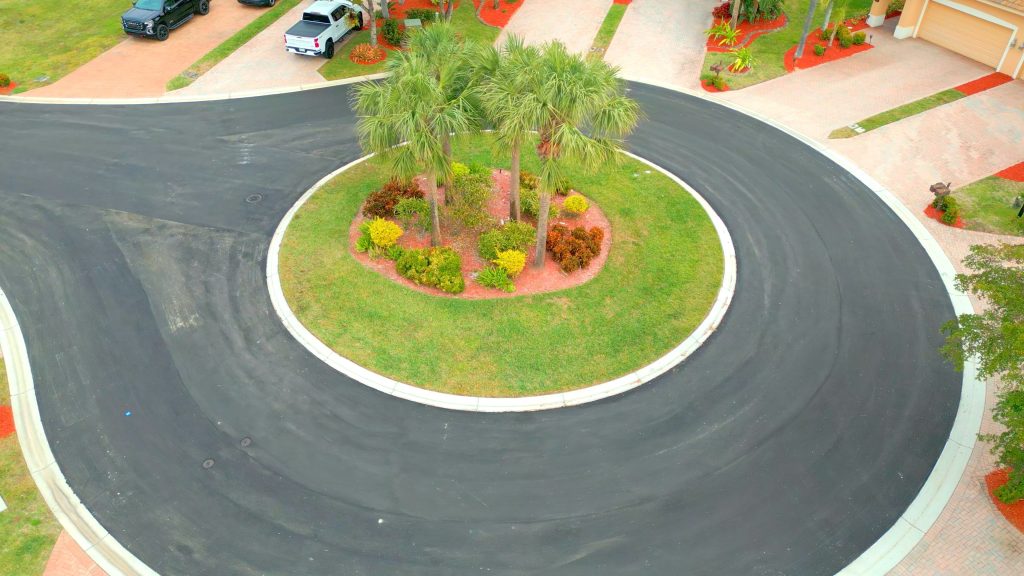Cracks and potholes aren’t just eyesores—they’re the early warning signs of serious damage lurking beneath your commercial asphalt surface. If left untreated, they can quickly lead to structural failures, expensive repairs, and safety liabilities.
In commercial properties, fast, effective repairs aren’t optional. They’re critical for asset preservation, customer satisfaction, and risk management.
Here’s a breakdown of the most effective ways to repair cracks and potholes in commercial asphalt.
Understanding the Problem: Why Cracks and Potholes Form
Before diving into solutions, it’s important to understand the root causes:
- Oxidation makes asphalt brittle and prone to cracking
- Water infiltration weakens the base layers
- Freeze-thaw cycles expand cracks and create voids
- Heavy vehicle loads stress weak points, especially in high-traffic zones
- Poor drainage accelerates base erosion and pothole formation
Without early intervention, minor cracks and surface failures can turn into major liabilities, both financially and legally.
The Best Ways to Repair Cracks in Commercial Asphalt
1. Crack Sealing
Best for: Working cracks (those that expand/contract with temperature changes)
Crack sealing involves filling the crack with a hot-pour rubberized sealant that remains flexible year-round.
Benefits:
- Prevents water intrusion
- Extends the surface lifespan
- Reduces freeze-thaw damage
- Cost-effective compared to resurfacing
Pro Tip: Only apply crack sealant when the crack is 1/8″ wide or larger. Tiny surface cracks may not require sealing but should be monitored during inspections.
2. Crack Filling
Best for: Non-working cracks (those with minimal movement)
Crack filling uses a stiffer asphalt-based material that’s ideal for small surface cracks that don’t shift with temperature swings.
Key differences from sealing:
- Less flexible
- Shorter lifespan
- Lower cost for non-dynamic cracks
In a commercial setting, crack filling is often combined with sealcoating to provide full-surface protection.
3. Routing and Sealing
Best for: Heavy-duty commercial lots and high-traffic areas
Routing involves widening and deepening the crack into a uniform channel before applying sealant. This method ensures better adhesion, more sealant volume, and longer repair life.
It’s especially effective in commercial lots that see:
- Delivery truck traffic
- Loading dock use
- Large equipment access
Routing adds to the upfront cost but significantly improves the durability of the crack repair.
The Best Ways to Repair Potholes in Commercial Asphalt
1. Pothole Patching (Cold Patch)
Best for: Temporary, emergency repairs
Cold patch asphalt is premixed and can be applied even in wet or cold conditions. It’s ideal for rapid pothole filling during winter months when hot mix plants are closed.
Limitations:
- Not a long-term solution
- Can ravel or dislodge under heavy traffic
- Often needs replacement within months
Use cold patch to eliminate hazards quickly, then schedule permanent repairs when weather allows.
2. Infrared Asphalt Repair
Best for: Surface-level potholes and seamless finishes
Infrared repair involves heating the existing asphalt to 300+ degrees, raking the softened material, adding fresh hot mix, and compacting it into a seamless patch.
Advantages:
- Reuses existing material (eco-friendly)
- No saw-cutting or cold seams
- Quick turnaround—repaired areas ready in hours
- Superior cosmetic appearance
Infrared repair is an excellent option for commercial lots that prioritize aesthetics and fast reopen times.
3. Full-Depth Patching
Best for: Severe potholes or base layer failures
If a pothole has compromised the base aggregate layer, a full-depth patch is required. This method involves:
- Cutting and removing the damaged asphalt
- Recompacting or replacing the base material
- Installing new hot mix asphalt
- Compacting to restore grade and structure
Full-depth patching restores structural integrity and stops the spread of subsurface failures into adjacent areas.
Important: Always match the patch thickness to the original pavement thickness to avoid weak points.
Choosing the Right Repair Method: Key Factors
Not all damage is equal. Here’s what The Pavement Group looks at when recommending a repair:
- Crack size and movement: Determines sealing vs. filling
- Extent of base failure: Surface vs. full-depth solutions
- Traffic volume: Higher traffic volume = stronger, longer-lasting repairs needed
- Timing and weather: Cold patch vs. permanent hot mix
- Budget and priorities: Balancing short-term fixes with long-term value
Real-World Example: Retail Center Parking Lot in Charlotte, NC
A national retailer with a 120,000 sq. ft. parking lot noticed potholes forming near the loading docks. The Pavement Group recommended a combination of infrared repair for minor areas and full-depth patching for severely damaged zones. The result: seamless repairs completed over a weekend, with zero disruption to weekday operations.
Trust The Pavement Group for Commercial Asphalt Repairs
When it comes to crack and pothole repair, experience matters. The Pavement Group specializes in fast, durable, cost-effective repair solutions nationwide for commercial properties.
We help you:
- Evaluate the damage properly
- Choose the right repair method
- Extend the life of your asphalt assets
- Minimize downtime and liability risks
Contact The Pavement Group today for a commercial asphalt inspection and repair plan built around your property’s needs.


